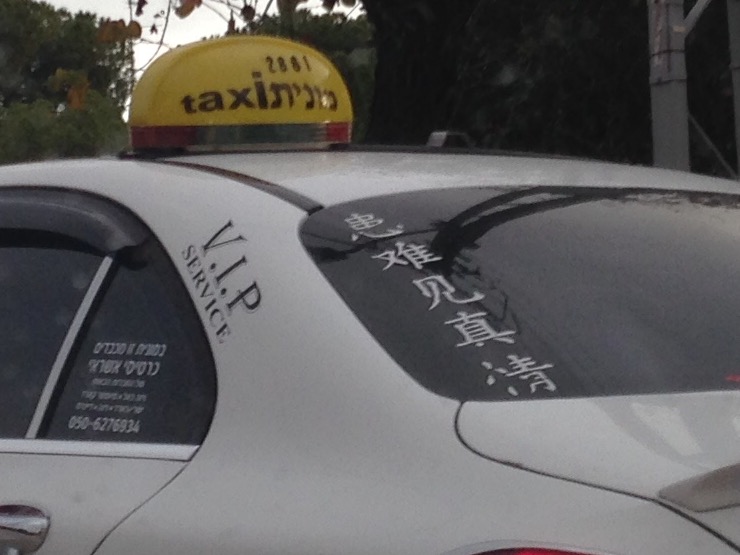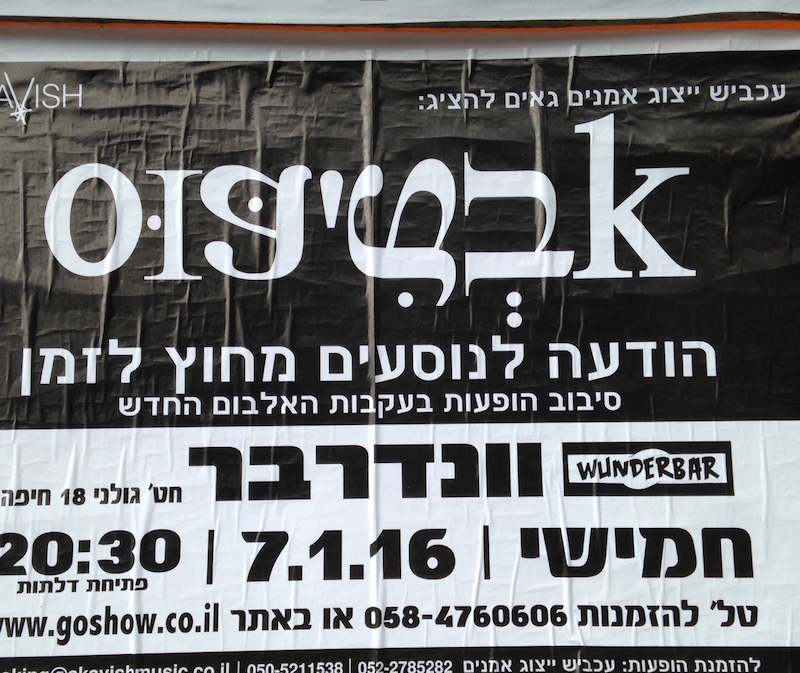More biscriptal examples from Israel
« previous post | next post »
Last month, in "Apostrophe in Hebrew" (11/22/16), we saw an "s" and an apostrophe incorporated in Hebrew writing. Here, on top of a taxi, from left to right it says "taxi", and from right to left it says מוֹנִית ("taxi").
Since it's unusual to see Chinese writing publicly displayed in Israel, more curious to me are the characters arranged vertically on the left side of the back window:
huànnàn jiàn zhēnqíng 患难见真情
("a friend in need is a friend indeed; misfortune tests the sincerity of friends; true friendship stands out in time of adversity")
The last time I was in Israel, a couple of years ago, I saw lots of Chinese workers in certain restricted areas. I'm going again at the end of this week, so perhaps I'll see evidence of Chinese — and their language and script — moving around a bit more freely.
And here is another instance of biscriptalism (on a poster seen in Haifa, Israel):
Wendy Heller, who sent in both of these photographs, observes:
It says "Abtipus" (Prototype) ( אבטיפוס ), read right to left, complete with vowel pointing, and is the name of a rock band. Here by the way the apostrophe is supposed to be an "I"! Some of the letters are supposed to approximate Hebrew cursive script.
I'll be on the lookout for more examples of biscriptalism during my upcoming trip to Israel and will share any interesting specimens I come across.


B.Ma said,
December 12, 2016 @ 6:34 am
I may be missing something but how is the taxi an example of biscriptalism as opposed to just 2 languages?
I'm not sure I understand the second image either. Is it just Latin letters which resemble Hebrew letters (like the recent Gallerias Ko/Jap example)?
Victor Mair said,
December 12, 2016 @ 8:58 am
I asked one of our students who is in Israel right now what she thought of the placement of those particular Chinese characters on the back window of the taxi. She replied:
=====
I have no idea, but my guess is that they think Chinese characters are cool, similarly to those who tattoo Chinese characters without knowing their real meaning. It's the only thing I can think of other than attempting to get Chinese tourist passengers. That's a pretty entertaining picture!
=====
Belial Issimo said,
December 12, 2016 @ 12:18 pm
The "abtipus" is a bit odd – the stylized letters (i.e. the deformed Latin characters) all stand in for what would be printed characters in Hebrew, except for the aleph, represented by Latin-alphabet k, which is cursive. To be consistent that letter would have to have been represented by an x probably…but I suppose consistency was not really the objective there.
Jonathan said,
December 12, 2016 @ 12:23 pm
In the Haifa picture I like what's going on in the line that says "Wunderbar". I'm guessing that's the name of the club where they're playing (We've got our own "Wonder Bar" in Boston — it's probably a common play on words.), but is the next word 1) a transliteration of the name into Hebrew letters, or 2) a Yiddish translation.
Seriously, it's very likely the first, as I don't think Yiddish is common among rock club visitors in Israel these days. Also, Google translate says the word in Yiddish is ווונדערלעך, with explicit vowels and ending in -lich, not -bar. But it's fun to contemplate the possible ambiguity.
BZ said,
December 12, 2016 @ 12:54 pm
@Jonathan, the Hebrew "Wunderbar" is ambiguous as to what vowel follows the W. It could be a U or an O (though the doubling of the letter serves to exclude anything but those two possibilities)
Ran Ari-Gur said,
December 13, 2016 @ 12:03 am
@BZ: In this case the double vav just indicates /w/; it doesn't tell us anything about the vowel that follows. (Cf. "וואלה", https://en.wikipedia.org/wiki/Walla%21.)
Michael said,
December 14, 2016 @ 5:04 am
Indeed — Taxi in English and Hebrew is no more biscriptal than the ubiquitous trilingual signage (Hebrew, Arabic, English) all over Israeli roads and highways.
Coby Lubliner said,
December 15, 2016 @ 10:26 am
A couple of years ago I posted about a biscriptal (Latin and Hebrew) label I found in Los Angeles, in which the Hebrew script represents three languages (Hebrew, Aramaic and Yiddish) mixed together.